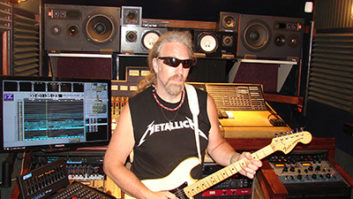When audio recording went digital, the one thing I wouldn’t give up was the way I liked to work—that is, having an autolocator with transport buttons and locate points in front of me and artists on the other side of the glass that can make eye contact with me (if they wanted to). The Otari RADAR II gives me those capabilities and more.
TRACKS, TRACKS, TRACKS
If I’m tracking vocals and don’t know how many tracks I’ll need (when do we ever?), then I copy my session project and print a quick reference mix. Now I can track onto 22 tracks, assemble a comp, drop it into the original tracking project and go. Need to track more? Just do it again! However, a lot of copying and pasting tracks from project to project simultaneously (for instance, moving a drum take) can tax RADAR’s Undo buffer memory. I’ve had some lock-ups when asking the machine to remember too many edits between too many projects across too many tracks. Here, the solution is simple: Temporarily reduce the number of Undos to two or so. Alternatively, you can purge the Undo memory by reducing each project Undo Level to zero and then putting it back to your standard setting.
SWAP, PLUG, PLAY!
I often work with a producer who has several RADAR II units, and this allows me to do things that would otherwise interrupt the session flow. If a song has been tracked onto one of his machines, then I can swap drives, plug his drive into my machine and access the music just tracked for editing, while he moves on to the next song. Meanwhile, I can compile edited tracks, rearrange the track layout, make backups and have the latest version available for him the next time he goes back to the song. And as all of the session setup information lives with the audio files on the removable drive, it’s plug-and-play from machine to machine.
TRANSFER AND EDIT
If the edit requirement goes beyond the abilities of RADAR II, then a digital transfer to another platform is accommodated by multiple I/Os and sync options. The fact that a hard disk recorder derives its wordclock and SMPTE from subdivisions of the same clock source (the crystal clock of the host computer) requires some special care. If a SMPTE frame rate gets out of step with the wordclock rate, then the resulting confusion will cause snatting and drop out. Because the math performed by both computers involved is the same, if one has agreement between wordclock and SMPTE, then the other will too. So the standard “the audio source machine is the wordclock and SMPTE master” approach works. In situations where RADAR II must be the SMPTE source on transfer back from the editing platform, we have to resolve the fact that it’s looking for external wordclock (embedded in the digital input) that will agree with its internal SMPTE. By synching both RADAR and the editing machine to a third external and independent wordclock source, the SMPTE math usually makes sense at both ends. It’s the same principle as house video sync. If your word sync scheme involves the use of RADAR’s rear panel BNC connector, then be aware that RADAR II has a Preferences menu setting for the sync output of Word Clock or Thru.
SLAVES & CLONES
Besides using RADAR as my main multitrack recorder, I use RADAR II when I need an additional slave or want to archive tracks from another platform. And even on an all-analog session, a RADAR II slave copy of an analog reel allows the original tape to sit on the shelf until mix. I’ve used it to print stem mixes for projects that require 24-bit split-outs for film or surround. I’ve used it as an easily portable multitrack when I’ve had to record an orchestra and then bring the tracks back to a project studio. The sync features on RADAR II will allow reliable use in any application if you think through the clocking scheme of the setup.
DESIGNER FUNCTIONS
RADAR II’s user-programmable macro keys allow me to string up commands from the extensive menu lists in the machine. Commands such as Mute Tracks can be accessed with a single keystroke. Complex sync setups can be made easy to execute. I try to create macros that keep me from looking like a computer operator during tracking sessions.
A Los Angeles-based recording engineer and programmer, David Channing misses the smell of analog tape.




